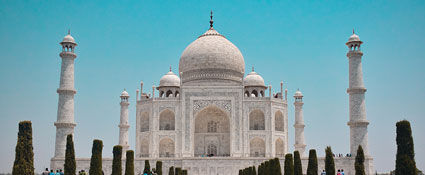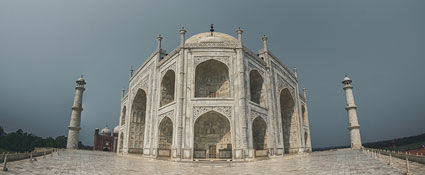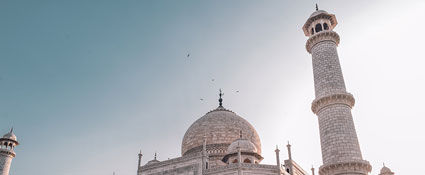15 Facts About the Taj Mahal: A Chronicle of the Modern Wonders of the World
- Studio 324

- Oct 1, 2023
- 6 min read
In 1632, the awe-inspiring Taj Mahal was commissioned by the Mughal emperor Shah Jahan as a monument to honor his beloved late wife, Mumtaz Mahal. This architectural marvel stands as a symbol of enduring love and showcases breathtaking design principles influenced by Indian, Persian, and Islamic cultures.
Crafted from luminous white marble, the Taj Mahal's appearance seems to transform magically throughout the day, with its color shifting in harmony with the sun's movements. Spanning an impressive expanse of nearly 17 hectares, or approximately 42 acres (equivalent to about 20 football fields), this mausoleum complex is a testament to the grandeur of its construction.
The construction of the Taj Mahal was an extraordinary feat that required 20 years of dedicated work and the efforts of an astounding 20,000 skilled workers. This magnificent structure not only houses the remains of Mumtaz Mahal but also serves as the final resting place for Shah Jahan himself. Let us now embark on a journey to explore some captivating facts about this iconic wonder that will leave both you and your and friends in awe.
A Monument of Love:
Emperor Shah Jahan, the fifth ruler of the Mughal dynasty, reigned from 1628 to 1658. When his cherished wife, Mumtaz Mahal—a noble princess from Persia and a native of Agra—passed away, Shah Jahan was overwhelmed by grief. Determined to immortalize their love, he envisioned the Taj Mahal as an everlasting symbol of their bond. It is worth noting that there are other mausoleums within the same complex that honor Shah Jahan's other wives and favorite servants, displaying his deep respect and thoughtfulness towards them as well.
Unveiling the Mystery of the Black Taj:
Legend has it that Shah Jahan desired to build a black marble Taj as his own tomb, known as the Black Taj or the Kaala Taj. This legendary structure was supposedly planned to stand across the Yamuna River, directly opposite the Taj Mahal. Shah Jahan envisioned a connecting bridge between the two mausoleums. While historians continue to debate the validity of this tale, the people of Agra, whose families have resided there since Mughal times, have faithfully passed down the legend of the Black Taj. Some believe that its existence remains obscured by history as it was allegedly demolished by Shah Jahan's son, who overthrew and imprisoned him.
A Monument Built by Many Hands:
The Taj Mahal's vast mausoleum complex covers nearly 17 hectares of land. Constructed using red sandstone and adorned with large marble plates, this architectural wonder called upon artisans from various countries and regions, including Central Asia, Iran, Syria, and Turkey. These skilled craftsmen dedicated two decades to bring Shah Jahan's vision to life, with more than 20,000 artisans contributing their expertise. While rumors persist of Shah Jahan severing the hands of these artisans to ensure their inability to replicate such a masterpiece, this remains a myth without any supporting evidence. It appears that the workers were not only well-compensated but also esteemed for their invaluable skills required for the creation of the Taj Mahal.
The Majestic Journey of a Thousand Elephants:
Transporting the necessary building materials for the Taj Mahal was an enormous undertaking, aided by over a thousand elephants. The magnificent structure primarily required white marble and red sandstone, sourced from different regions of India and the Middle East. While red sandstone, a common feature in Persian architecture, can be observed in other Mughal structures such as the Red Fort and Jama Masjid in Delhi, the choice of white marble symbolizes the divine.
The Ever-Changing Hue of Love:
The Taj Mahal's resplendent white marble exhibits a remarkable color transformation throughout the day, reflecting the changing moods of the late emperor during his time with Mumtaz Mahal and after her untimely demise. From the golden radiance of sunrise to the deep blue hues of nightfall, this shimmering masterpiece captivates the beholder with its kaleidoscope of colors.
Mud-Pack Treatment for Eternal Radiance:
India's persistent issue of high pollution levels, particularly in the northern regions like Agra, poses a threat to the Taj Mahal's pristine white marble. Over time, pollution has caused a yellowing effect on the monument's surface. In response, a traditional mud-pack treatment has been employed to counteract this discoloration. Archeologists believe that this specialized treatment, akin to the face packs used by Indian women to restore a natural glow, will help preserve the mausoleum's original sheen and color.
Gemstone Splendor:
Upon entering the Taj Mahal, visitors are greeted by a plethora of enchanting floral patterns intricately inlaid into the walls. These exquisite designs, created using the pietra dura technique—an intricate jigsaw-like inlay—depict tulips, lilies, irises, poppies, and narcissus. To bring these vibrant flora to life, craftsmen utilized 28 different types of precious and colorful stones, including orange carnelian, multi-colored agates and chalcedonies, blue lapis lazuli, bloodstone, and garnet. Sadly, many of these precious stones were stripped and looted by the British army during the Indian Mutiny of 1857. Additionally, the walls of the Taj Mahal showcase beautiful Arabic calligraphy, featuring verses from the Quran that speak of paradise. One can almost imagine the Taj glistening in full glory under the Indian summer sun through the 1600s and 1700s before its unfortunate stripping.
The Price of Eternal Love:
The grandeur of the Taj Mahal came at an astonishing cost, amounting to over INR 32 million in 1653, which would be equivalent to a staggering US$1 billion today. This remarkable expenditure demonstrates the extent to which Shah Jahan depleted the treasury of the Mughal Empire to honor his beloved wife.
Imperfect Symmetry, Perfect Harmony:
Following the principles of Persian and Islamic architecture, the Taj Mahal exhibits near-perfect symmetry. The minarets, walls, rooms, and gardens all adhere to precise geometric proportions, creating a harmonious composition. However, the symmetry is broken at the placement of Shah Jahan's cenotaph and grave, which deviates from the perfect balance. These design choices not only reflect traditional norms, where the male tomb is larger than the female tomb, but also add a unique touch to the symmetrical wonder that is the Taj Mahal. This asymmetry almost seems like a consequence of circumstances with the overthrowing of Shah Jahan by his own son. This irregular asymmetry also only furthered the notion of the Black Taj Mahal across the river, which was to be Shah Jahan's actual resting place.
A Monument of Height and Comparison:
Standing tall at a height of 73 meters (240 feet), the Taj Mahal holds its place among the world's remarkable structures. Although it is only half the height of the Great Pyramid, its pinnacle aligns with the book held by the Statue of Liberty and reaches the clock of Big Ben. Impressively, the Taj Mahal towers over both the Leaning Tower of Pisa and the first floor of the Eiffel Tower, surpassing them by 16 meters (53 feet).
The Subtle Battle Against Time:
Beside the Yamuna River, the foundations of the Taj Mahal rest on wooden supports. The wood retains its strength when kept wet, a requirement that poses a challenge as the Yamuna River is slowly drying up. Concerns have been raised about the potential threat to the Taj Mahal as the diminishing water levels may impact the stability of its foundation.
The Persian Architect Behind the Marvel:
While the Taj Mahal beautifully fuses Islamic, Persian, and Indian architectural styles, it was Ustad Ahmad Lahauri, a Persian architect, who served as the chief architect of this grand structure. Lahauri held a prestigious position in Shah Jahan's court during India's golden age of Mughal architecture. In addition to his involvement in the construction of the Taj Mahal, he also played a significant role in laying the foundations of the Red Fort in Delhi.
The Artful Illusion of Leaning Minarets:
The four minarets that grace the Taj Mahal were intentionally constructed with a slight outward lean. This ingenious architectural calculation not only enhances the monument's grandeur when viewed from a distance but also ensures the safety of the Taj's main dome. The slight outward inclination of the minarets prevents them from falling directly onto and potentially damaging the central dome in the event of an earthquake.
Preserving Pristine Beauty:
To maintain the impeccable allure of the Taj Mahal, no artificial lights are used to illuminate it at night. The absence of lighting serves the purpose of deterring insects, as their presence could tarnish the pristine marble surface. During nights with a full moon, the natural moonlight bathes the monument, allowing it to be clearly visible without the need for artificial illumination. Additionally, the decision to refrain from illuminating the Taj also helps minimize potential security threats.
Concealing Beauty in Times of War:
As a magnificent landmark, the Taj Mahal faced vulnerability during times of conflict, particularly during World War II and various Indo-Pakistani conflicts throughout the 20th century. To safeguard its splendor, the British and Indian governments employed a clever ruse. Bamboo scaffolding and covers were erected over the Taj's dome, creating an illusion that obscured its true beauty. This ingenious tactic effectively deceived enemy pilots, ensuring the preservation of this remarkable wonder throughout multiple wars.
The Taj Mahal, a true testament to everlasting love and architectural brilliance, continues to inspire awe and wonder. Its grandeur and intricate details tell stories of devotion and unparalleled craftsmanship. As we explore its enchanting history and captivating features, let us cherish and protect this extraordinary wonder for generations to come. You can now frame your memory of your trip to Agra with Studio 324's travel poster.
















Comments